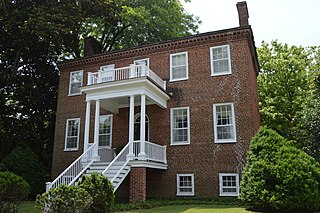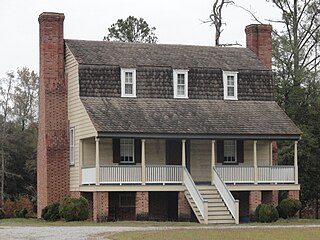
Murfreesboro is a town in Hertford County, North Carolina, United States. The population was 2,835 at the 2010 census. The town is home to Chowan University.

Walter Reed was a U.S. Army physician who in 1901 led the team that confirmed the theory of Cuban doctor Carlos Finlay that yellow fever is transmitted by a particular mosquito species rather than by direct contact. This insight gave impetus to the new fields of epidemiology and biomedicine, and most immediately allowed the resumption and completion of work on the Panama Canal (1904–1914) by the United States. Reed followed work started by Finlay and directed by George Miller Sternberg, who has been called the "first U.S. bacteriologist". He was 6.3 ft tall

Jesse Johnson Yeates was a Democratic U.S. Congressman from North Carolina between 1875 and 1881.
William Hardy Murfree, born in Hertford County, North Carolina, was a member of the United States House of Representatives from North Carolina.
The Brady C. Jefcoat Museum of Americana is a museum in Murfreesboro, North Carolina, USA. Operated by the Murfreesboro Historical Association, the museum houses a collection of American artifacts from the 1850s to the 1950s collected by Brady C. Jefcoat of Raleigh, North Carolina, a local plumber, electrician and general contractor.

John Hill Wheeler (1806–1882) was an American attorney, politician, historian, planter and slaveowner. He served as North Carolina State Treasurer (1843–1845), and as United States Minister to Nicaragua (1855–1856).
Wheeler House or Wheeler Home or variations may refer to:
John Wheeler House may refer to:

Melrose is a historic home located in the Murfreesboro Historic District at Murfreesboro, Hertford County, North Carolina. It was built about 1805, as a two-story, Federal-style brick dwelling with a gable roof and interior end chimneys. Two-story, two-bay, Greek Revival-style wings were added in the mid-19th century. It is seven bays wide and features a tetrastyle portico supported by Ionic order columns and a Second story semi-circular balcony. It was built by Congressman William H. Murfree, son of Hardy Murfree.

Myrick House is a historic home located in the Murfreesboro Historic District at Murfreesboro, Hertford County, North Carolina. It was built about 1805, and is a two-story, five-bay, Federal-style brick dwelling with a low hip roof and interior end chimneys. The front facade features a one-story hip roofed front porch supported by four fluted columns. It has a one-story, frame rear wing. It was built by James Morgan, a prominent local merchant.

Roberts-Vaughan House is a historic home located in the Murfreesboro Historic District at Murfreesboro, Hertford County, North Carolina. It was built about 1805, as a two-story, five-bay, Federal style frame dwelling with a gable roof. The front facade features a large three bay tetrastyle pedimented portico in the Greek Revival style. It was built by Benjamin Roberts, a prominent local merchant.

John Wheeler House is a historic home located in the Murfreesboro Historic District at Murfreesboro, Hertford County, North Carolina. It was built about 1805, and is a two-story, three-bay, vernacular Federal-style Flemish bond brick dwelling with a central passage plan. The front facade features a later two-story pedimented portico. It was the birthplace of John H. Wheeler (1806-1882) and later home of Congressman Jesse Johnson Yeates (1829-1892).

William Rea Store is a historic commercial building located in the Murfreesboro Historic District at Murfreesboro, Hertford County, North Carolina. It was built about 1790, and is a two-story, three-bay, brick building with a one-story, three-bay wing. It is one of the oldest commercial buildings in North Carolina. The brickwork is laid in Flemish bond. It was built by William Rea, a wealthy Boston merchant.

Freeman House, also known as The Hertford Academy, is a historic school building located in the Murfreesboro Historic District at Murfreesboro, Hertford County, North Carolina. It was built about 1810, and is a two-story, Federal-style brick building with a hip roof and central passage plan. Its brickwork is laid in Flemish bond. It is considered the birthplace of Chowan University.

The Columns, also known as the McDowell Columns Building, is a historic school building located at Murfreesboro, Hertford County, North Carolina. It was built about 1852, and is a three-story, Greek Revival-style stuccoed brick building with a low hip roof and octagonal belvedere. The front facade features a massive portico supported by eight Doric order columns. It was built to house the Chowan Baptist Female Institute, later Chowan University. The building houses the school's administrative offices.
Myrick–Yeates–Vaughan House, also known as the Yeates–Vaughan House, Uriah Vaughan Jr. House, and Sarah Vaughan House, was a historic home located at Murfreesboro, Hertford County, North Carolina. The "T"-plan house consisted of an earlier 1+1⁄2-story Federal style rear section with a two-story Greek Revival style front section. The Greek Revival was built between 1851 and 1855. It was owned by Congressman Jesse Johnson Yeates (1829-1892) during the 1870s. The house has been demolished.
Cowper-Thompson House, also known as the William Cowper House and Reverend Thompson House, is a historic home located at Murfreesboro, Hertford County, North Carolina. It was built about 1790, and is a 1+1⁄2-story, five-bay, transitional Georgian / Federal style frame dwelling with a center-hall plan. It is sheathed in weatherboard and is connected to the original kitchen dependency by a new kitchen addition. The house was restored in 1978–1980.

Francis Parker House, also known as Parker's Big Run or High House, is a historic home located near Murfreesboro, North Carolina and Northampton County, North Carolina. It was built about 1785, and is a 1+1⁄2-story, hall and parlor plan, Georgian style frame dwelling with a one-story rear wing. It has a gambrel roof, is sheathed in weatherboard, sits on a raised brick basement, and rebuilt massive paved double-shoulder exterior end chimneys. The house was moves to its present location in 1976. The contributing Vaughan house and pyramidal-roof frame dairy, were also moved to the site.

Hertford Historic District is a national historic district located at Hertford, Perquimans County, North Carolina. The district encompasses 219 contributing buildings, 2 contributing sites, 1 contributing structure, and 1 contributing object in the central business district and surrounding residential sections of Hertford. The district developed between about 1759 and 1948, and includes notable examples of Federal, Greek Revival, and Gothic Revival style architecture. Located in the district are the separately listed Perquimans County Courthouse and Church of the Holy Trinity. Other notable buildings include the Creecy-Skinner-Whedbee House, Edward Wood House, Matthews-Jacocks House, Temperance Hall (1851), Matthew H. White House, Dr. Thomas S. McMullan House (1905), Thomas Nixon House, William M. Divers House (1924), W.R. Shannonhouse Building (1895), Darden Department Store, Farmers National Bank of Hertford (1916), State Theatre (1937), Old Hertford Post Office (1915), Hertford Baptist Church (1854), and Hertford United Methodist Church (1901).
Old Neck Historic District is a national historic district located at Belvidere, near Hertford, Perquimans County, North Carolina. The district encompasses 44 contributing buildings, 5 contributing sites, 12 contributing structures, and 1 contributing object in a rural agricultural area near Hertford. The district developed between about 1813 and 1946, and includes notable examples of Federal and Greek Revival, and Colonial Revival style architecture. Located in the district are the separately listed Fletcher-Skinner-Nixon Plantation and Cove Grove Plantation. Other notable buildings include the Francis Nixon Plantation, William Jones Plantation, Thomas Nixon Plantation, Winslow Farm, John Newbold Farm, and Matthew Towe Farm.

















